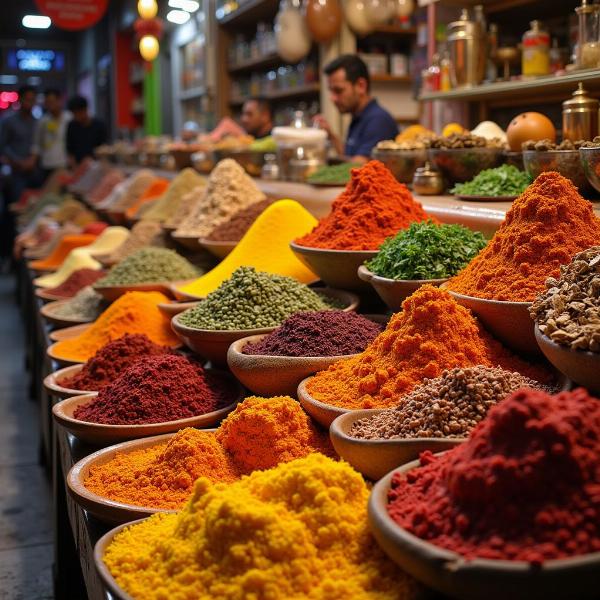Understanding the phrase “I am making food” and its nuances in Hindi can be incredibly helpful for anyone navigating Indian culture, whether you’re a traveler, a language learner, or simply curious about the intricacies of Hindi. This seemingly simple phrase can be translated in several ways, each reflecting a specific level of formality and cultural context. The most common and versatile translation is “मैं खाना बना रहा हूँ” (Main khana bana raha hun). This phrase is suitable for most situations and clearly conveys the act of preparing a meal.
Different Ways to Say “I Am Making Food” in Hindi
The beauty of Hindi lies in its richness and flexibility. There are various ways to express “I am making food” depending on the context. Let’s explore some of these nuances:
- Formal: “मैं भोजन तैयार कर रहा हूँ” (Main bhojan taiyaar kar raha hun) – This translation uses the more formal word “bhojan” for food and “taiyaar kar raha hun” for preparing, making it suitable for more formal settings.
- Informal: “मैं खाना बना रहा हूँ” (Main khana bana raha hun) – As mentioned earlier, this is the most common and widely accepted translation for everyday conversations.
- Feminine: “मैं खाना बना रही हूँ” (Main khana bana rahi hun) – The only difference here is the ending verb conjugation (rahi hun) indicating a female speaker.
- Plural: “हम खाना बना रहे हैं” (Hum khana bana rahe hain) – This translates to “We are making food.”
- Specific Dishes: Instead of the generic “khana” (food), you can substitute the specific dish you’re preparing. For example, “मैं रोटी बना रही हूँ” (Main roti bana rahi hun) means “I am making roti.”
Understanding the Cultural Context of Food in India
Food is not just sustenance in India; it’s an integral part of the culture, woven into the fabric of everyday life, rituals, and celebrations. The act of making food is often seen as an act of love and care. Understanding this cultural significance adds depth to the simple phrase “I am making food.”
The Importance of Fresh Ingredients
Indian cuisine emphasizes fresh, locally sourced ingredients. From vibrant spices to seasonal vegetables, the focus is on maximizing flavor and nutritional value.
Regional Variations
India’s diverse regions boast a rich tapestry of culinary traditions. Each region has its own unique dishes and cooking methods, adding to the country’s gastronomic diversity.
 Vibrant Indian Spice Market
Vibrant Indian Spice Market
Common Questions About Making Food in Hindi
What if you want to ask someone if they are making food? Here are a few options:
- Formal: “क्या आप भोजन तैयार कर रहे हैं?” (Kya aap bhojan taiyaar kar rahe hain?)
- Informal: “क्या तुम खाना बना रहे हो?” (Kya tum khana bana rahe ho?)
Conclusion
Understanding the various ways to say “I am making food” in Hindi, along with its cultural context, provides a deeper appreciation for the language and the rich culinary traditions of India. Whether you’re asking a friend what they’re cooking or informing your family about your culinary endeavors, knowing these nuances can enhance your communication and cultural understanding. So, the next time you’re in India or conversing with Hindi speakers, try incorporating these phrases and experience the language’s expressive power.
FAQ
- What is the most common way to say “I am making food” in Hindi? The most common way is “मैं खाना बना रहा हूँ” (Main khana bana raha hun).
- How do you say “I am making roti” in Hindi? You can say “मैं रोटी बना रही हूँ” (Main roti bana rahi hun).
- What is the formal way to say “I am making food” in Hindi? The formal way is “मैं भोजन तैयार कर रहा हूँ” (Main bhojan taiyaar kar raha hun).
- How do you ask someone if they are making food in Hindi? Informally, you can ask “क्या तुम खाना बना रहे हो?” (Kya tum khana bana rahe ho?). Formally, ask “क्या आप भोजन तैयार कर रहे हैं?” (Kya aap bhojan taiyaar kar rahe hain?).
- Why is food important in Indian culture? Food is integral to Indian culture, representing love, care, and is deeply connected to rituals and celebrations.
- What is the significance of fresh ingredients in Indian cooking? Fresh, local ingredients are prized in Indian cuisine for their flavor and nutritional value.
- Are there regional variations in Indian food? Yes, India’s diverse regions have unique dishes and cooking methods, contributing to its rich culinary tapestry.
Meaning-Hindi.in is your one-stop solution for all your Hindi translation needs. We offer a wide range of services, from business and legal document translation to website localization and specialized technical translation. Our expert team ensures accurate and culturally sensitive translations, catering to your specific requirements. Need help with translating your culinary content or any other document? Contact us at [email protected] or call us at +91 11-4502-7584. Meaning-Hindi.in is committed to delivering high-quality, professional translations that bridge language barriers and connect cultures.